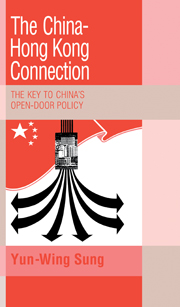Book contents
- Frontmatter
- Contents
- List of tables
- Preface
- Abbreviations
- Symbols
- Introduction
- 1 The open-door policy
- 2 The pivotal role of Hong Kong
- 3 The institutional setting
- 4 Evaluation of the open-door policy
- 5 Hong Kong as financier
- 6 Hong Kong as trading partner
- 7 Hong Kong as middleman
- 8 Summary and conclusions
- Appendix: Estimates of retained imports from China by commodity
- References
- Index
Introduction
Published online by Cambridge University Press: 01 June 2011
- Frontmatter
- Contents
- List of tables
- Preface
- Abbreviations
- Symbols
- Introduction
- 1 The open-door policy
- 2 The pivotal role of Hong Kong
- 3 The institutional setting
- 4 Evaluation of the open-door policy
- 5 Hong Kong as financier
- 6 Hong Kong as trading partner
- 7 Hong Kong as middleman
- 8 Summary and conclusions
- Appendix: Estimates of retained imports from China by commodity
- References
- Index
Summary
The open-door policy that has evolved in China since the death of Mao Zedong and the Purge of the Gang of Four in 1976 has had far-reaching repercussions for the Chinese economy as well as for the world economy. The open-door policy is a vital part of China's new development strategy of intensive growth — growth through adaptation and diffusion of technology, especially foreign technology. Although China imported foreign technology, including capitalist technology, in Mao's era, the novelty of the ‘open door’ is the willingness to acquire technology through foreign investment. Moreover, foreign technology is broadly interpreted to include not only technology embodied in plant and equipment, but also knowledge, including management skills and even the practices and ideas of a modern society. The traditional mechanism of ‘arm's-length’ trade cannot adequately promote the transfer of this knowledge, and consequently closer interaction with foreigners through direct foreign investment has become a central element of the new development strategy. This recognition of the importance of direct foreign investment has accounted for the willingness of the Chinese to utilize special trade and various forms of industrial cooperation agreements.
Another vital aspect of China's modernization drive is the reform and partial marketization of China's Stalinist economic system. The open-door policy and the reform drive are mutually reinforcing. The commitment to the open-door policy forces China to modify a rigid economic system to facilitate economic interaction with world markets.
- Type
- Chapter
- Information
- The China-Hong Kong ConnectionThe Key to China's Open Door Policy, pp. 1 - 4Publisher: Cambridge University PressPrint publication year: 1991

